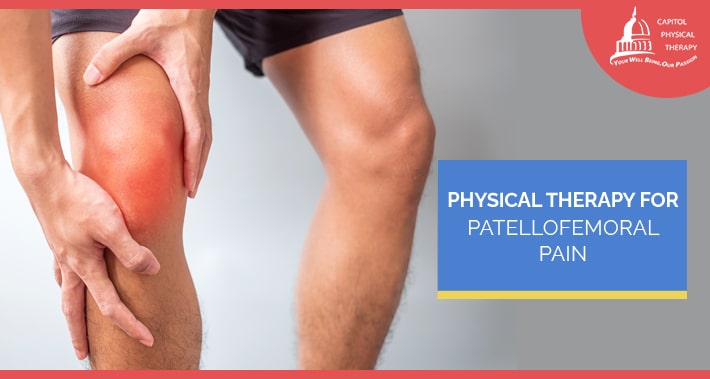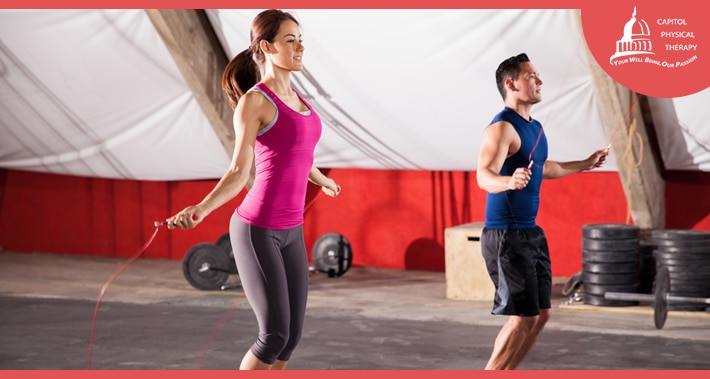
Do you have a persistent dull, aching pain in your knee?
Does the pain get worse when exercising, climbing stairs, or after sitting for long periods of time?
If so, you might be experiencing patellofemoral pain.
Also known as jumper’s or runner’s knee, patellofemoral pain is the most common type of knee pain in the United States and affects a wide range of people, including athletes, active teenagers, and older adults.
At Capitol Physical Therapy, we offer sports and running injury physical therapy for the management of patellofemoral pain.
If you think you might be dealing with patellofemoral pain, you’ve come to the right place.
Keep reading to find out more and how physical therapy can help.
What Is Patellofemoral Pain?
In medical terms, your kneecap is referred to as your “patella”.
Therefore, patellofemoral pain is pain which occurs at the front, under, or around your kneecap.
Patellofemoral pain is very common; accounting for up to 20-25% of all reported knee pain.
People assigned female at birth are more likely to experience patellofemoral pain than people assigned male.
Physical therapy is one of the most effective treatments for patellofemoral pain.
What Does Patellofemoral Pain Feel Like?
The most obvious symptom of patellofemoral pain is pain occurring in and around your kneecap.
The pain may range from mild to severe.
Its most often described as a dull, aching pain that may worsen when:
- Walking up or down stairs or hills
- Playing sports
- Participating in deep knee bending activities, such as squatting and lunging
- Walking on uneven surfaces
- After sitting for long periods of time with the knee bent
Patellofemoral pain is often improved with rest; however, it will continue to appear without treatment.
What Is Patellofemoral Pain Caused By?
Patellofemoral pain is often caused by a sudden increase in physical activity, such as running or jumping.
This occurs when your activity levels increase faster than your knees can keep up.
Some factors may contribute to the development of patellofemoral pain.
These include:
- Undertraining or overtraining
- Poor footwear use during athletic activities
- Poor balance and position sensation
- Weakness of thigh muscles
- Specializing in a single sport which requires repeated movements, such as basketball, volleyball, or cross country
- Poor coordination between your hip, knee and ankle patterns during running and jumping activities
Does Patellofemoral Pain Go Away On Its Own?
If your patellofemoral pain is only slightly uncomfortable, you might be tempted to take a “wait and see” approach.
But unfortunately, patellofemoral pain doesn’t go away on its own and can often worsen if ignored.
If you’ve been experiencing symptoms of patellofemoral pain, it’s important to seek treatment from a physical therapist right away so you can return to your favorite physical activity as soon as possible.

Can You Prevent Patellofemoral Pain?
Fortunately, there are some preventative measures you can take to reduce your chances of experiencing patellofemoral pain.
These include:
- Keeping your thigh muscles strong
- Exercising regularly
- Increasing your activity levels slowly
- Participating in a variety of sports rather than only one sport that requires repetitive movements
How Can Patellofemoral Pain Physical Therapy Help?
A physical therapist is qualified to help with both evaluation and management of patellofemoral pain.
Your physical therapist will evaluate your health history and knee function to rule out any other possible conditions, such as arthritis.
Special attention will be paid to any movement that causes knee pain.
Once the evaluation is finished, your physical therapist will put together a treatment plan that focuses on your specific strengths and needs.
Let’s take a closer look at some techniques commonly used by our DC physical therapists for the management of patellofemoral pain.
1. Balance And Coordination Training
Balance and coordination training is a useful method in helping retrain your hip, knee, and ankle movement patterns to reduce knee pain.
This physical therapy technique is specifically helpful for athletes and other active individuals.
Your physical therapist will focus on movements such as stair climbing, squatting, running, and jumping.
2. Exercises To Build And Maintain Strength
Exercises that help build and maintain strength are one of the most important factors in the management of patellofemoral pain.
Your physical therapist will teach you exercises that help strengthen the muscles around the hip and knee themselves.
By strengthening these muscles, your knee will be better capable of withstanding increased activity levels.
3. Cross Training
Cross training involves the incorporation of multiple activities in an exercise routine.
It’s particularly helpful for athletes and other activities individuals strengthen a variety of muscles.
For people experiencing patellofemoral pain, cross training is an excellent way to encourage activity until recovered enough to return to their regular physical activities.
4. Taping And Shoe Inserts
Finally, your physical therapist may include taping and shoe inserts in your treatment.
Taping involves applying tape to your knee to improve your ability to perform otherwise painful activities, such as squatting.
Shoe inserts are placed inside of your shoes and can help reduce your pain while exercising.
It’s important to note that both taping and shoe inserts will not help reduce patellofemoral pain alone and should be used alongside an exercise program.
Book Your Appointment With Capitol Physical Therapy Today
Unfortunately, patellofemoral pain is often a result of structural changes or poor form and does not tend to resolve without treatment
At Capitol Physical Therapy, we can put together a treatment plan to help manage your patellofemoral pain and put you on the road to recovery.
Book your appointment with Capitol Physical Therapy today to start working towards a less painful tomorrow.
1331 H St NW #200,
Washington, DC 20005
- https://g.page/capitolptdc
9560 Pennsylvania Ave. # 202,
Upper Marlboro, MD 20772
- https://goo.gl/maps/zjL4NnnuThRhrcS86
Capitol Physical Therapy offers orthopedic and other pain related solutions, with our versitile team of physical therapists in Washington, DC